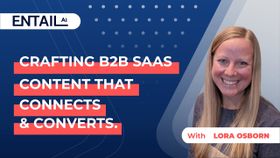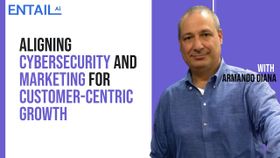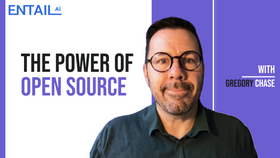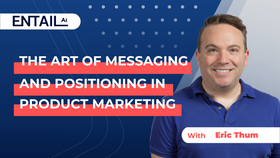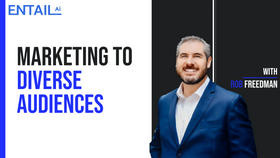Fintech marketing 101: Oleg Lebedev's strategies for creating lasting success
As the marketing world continues to evolve alongside new tech, brands need to up their content game and drive demand.
Updated June 11, 2024
Marketing competition is increasing drastically, and businesses must adapt to evolving marketing strategies to thrive.
To get an expert perspective, I spoke with Oleg Lebedev, whose more than 25 years of experience as a CMO includes driving growth for leading brands like Alibaba and Barclays.
In our discussion, Oleg and I explored the keys to effective marketing today—from the importance of building trust and becoming a media company to balancing performance marketing with long-term brand building.
While new technologies like AI enable efficiency, fintechs—and marketers in general—can’t lose the human touch. Combining high-tech storytelling with authenticity and truly understanding customer needs remains vital.
This conversation highlights essential marketing principles alongside emerging trends to take your marketing up a notch and grow your brand.
Hey, hello everybody. Today, I have the pleasure of having you here with me, Oleg Lebedev, CMO, ex Alibaba, and ex Barclays, with a lot of experience in marketing for e-commerce and finance. So happy to have you here, Oleg. How are you doing today?
It's great to be here. Thanks for having me. Yeah, I'm very good. How are you?
I'm fine, thank you. So I'd like to speak to you today about marketing strategies for fintech. But before we start, maybe you can take a moment to introduce yourself and your background.
Sure, I love to talk about myself. Thank you. So I've got more than 15 years of experience in marketing. I've worked in both really big companies like Alibaba and Barclays—big global corporations—and in startups, like 3S Money. And I love working for startups because it's a lot of fun. I've done quite a few marketing roles over time. And I find that in fintech and e-comm, marketing is really exciting, although it can be quite different. A few things are the same, such as the focus on brand, authenticity, and trust. Secondly, it's the ability to attract traffic effectively and convert traffic into leads. So those are the two key things that I think unite e-commerce and fintech or financial services in general.
Which marketing channels are your default or your favorite? As a CMO, you've probably done quite a lot of everything, but I can say for myself, there are often the types of marketing that I'm more attracted to. So, what is your go-to channel usually?
I don't have a specific one. It all depends on your target customers. It's really important to understand who your target customer is and where you can find them in the most effective way. If it's performance marketing, like Google ads or Meta ads on Facebook or Instagram, it could be that, or it could be SEO. You have to work for a few months to create lots of content to attract people. Or it could be offline. Offline also exists. You can go out. You can leave Zoom and go outside on the street to gather your customers there.
So it depends on the customer.
I have to be honest, I've never done anything offline for marketing. That's an interesting approach. Never really thought about this.
Understanding fintech marketing vs. other industries
And in general, in fintech, is there any real change or differences between fintech marketing and other industries, compared to e-commerce, in terms of which channels work, or does it have to do with the specific business you're working on?
Well, I think there's quite a difference between B2C and B2B fintech versus e-commerce. Some of the tools are similar; some are completely different. A key difference in any financial services marketing compared to other marketing is trust.
People are quite risk-averse, and this is especially true in financial marketing, where the importance of trust is multiplied tenfold.
And that's true for both B2B and B2C. It's the same challenge, right? But do you use different measures to address it?
Yes, it's a bit different. In B2B, your sales force—which most B2B businesses have—plays a huge part in creating and maintaining customer relationships, something you don't have in B2C. In B2C, it's about your UX, how good your product is, how convenient and quick it is, the quality of your advertising, and the effectiveness of your conversions.
In B2B, the human factor plays a much stronger role. It's very important to show business owners—the clients of B2B—that they're dealing with real people.
Yes, there are technologies, tools, and products, but it's important that there are real people behind them. People who go to a real office where you can see their faces, names, and what they do.
Fintech marketing strategies for success in 2024
In terms of fintech marketing strategies that you're using now, it's always interesting for marketers to hear about what people are doing now, because looking at other businesses and trying to understand their marketing strategies from the outside can often feel mysterious.
Could you share from your personal experience about what strategies you're seeing and what works for you now, in 2024, in terms of social media or using user-generated content (UGC), video content, etc.?
There are a few things that are really important in our strategy. First, to generate trust through your communication, you need to show not just the advantages of your product but also your human side.
For example, founder stories are very effective because successful founders often have experienced the pain that led them to create the business and the product. Telling these stories well and repeatedly across different media and social media platforms creates a lot of trust. It shows that the people behind the business truly understand what they're talking about and share the same feelings as their audience.
Another crucial aspect for financial services businesses in terms of creating trust is to show people that you have the licenses to do business. When I visit the website of an electronic money institution, I immediately scroll to the bottom to check for licenses for different countries or jurisdictions. If the license is from a country with poor financial controls, no matter how good the website looks, I won't deal with them. Licensing is very important.
The second thing that will be very important this year, as always, is content.
Nowadays, you have tools to help with this, notably AI. You've got to use these tools to create a lot of content in a very short period of time.
Back in the day, say 10 years ago, you had to wait a year and a half until your SEO efforts would pay off. Today, that's not the case. It can happen within two to four months of starting to produce a lot of content. Becoming a media company, however strange and absurd that might sound for a financial services or B2B financial services company, can be very beneficial. So, that's number two.
You're basically preaching to the choir here because I often tell people that they really need to become a media company.
Take a fashion business as an example, an e-commerce that sells clothes. Let's say they have a line targeting women, with 15 new dresses every month, and they need to constantly renew their inventory. With those 15 new dresses, they need to take photos for new product pictures, have models, and create videos and content for social media.
Essentially, they have their own media company in-house, filming models with the new clothes all the time. So, they operate like a media company. You can't be a fashion company, an e-commerce store selling clothes, if you don't have a media company in-house. If you don't have the capability to take professional photos of models, high quality, on a large scale, all the time, to upload new photos, you're missing out. Your style can vary. It doesn't necessarily have to look like traditional models; it can be more like user-generated content if that's your style. But the point is they have to produce a lot of content all the time.
Their content is models. We're in a different business. We're not doing content for the fashion industry; we're focused on expertise, experience, perspective, information, education, and so on. But still, if you want to play in the content game in 2024, you need to be able to create a lot of content.
One of the challenges, especially with AI now, is that it's become very inexpensive for companies to create content. As a result, companies need to increase the quality of their content because everyone can create cheap content with AI. If everyone can create cheap content with AI, Google doesn't want to index all the content that everyone creates because it's too much.
There's a hyperinflation of content. This is one trend that's really affecting what's happening on Google. Right now, companies using a lot of AI in their content creation may see results, but what's likely to happen soon is that Google will keep updating their algorithms to combat this. Not because there's an issue with using AI in content creation, but because of the hyperinflation of content and the need to find the best content, not just any content.
» More from the podcast: Ari Yablok discusses the importance of branding and standing out.
Shifting to a video-first approach
That's one trend. The other trend is video. Everybody's shifting to video. The world has shifted to video. Almost everyone now consumes more video than text, and we do so more on social media rather than other channels. So, what we say at Entail is companies need to be video first and create video content first.
Then you can also turn it into text content—into articles, posts for social media that include the captions and texts, and so on, but first, it's about video. I think that's very challenging for many companies. I'd like to hear your take on that. If you have any experience with that, or the companies you work with.
Creating videos that people would watch is a huge challenge. I've done lots of ads in my professional life, including TV ads, YouTube ads, TikTok ads—all kinds of ads. Whether you do this with AI, which might be cheap but not of the same quality yet today, or you do this manually or half-manually, how do you come up with an interesting story?
It's a huge challenge for both B2C and B2B businesses. I think it's a bigger challenge for B2B businesses because short videos are yet to become popular on LinkedIn. I don't see many short videos on LinkedIn. For a B2B company, diving into TikTok can be very intimidating because it's still, oddly enough, perceived as a platform for younger audiences, which is completely untrue.
I've seen all kinds of products being sold on TikTok, including private jets. I'm subscribed to this guy who sells private jets; it's unbelievable. And he does sell private jets on TikTok, so he gets leads from that.
It's a huge challenge. I personally have cracked it and scaled it for B2B solutions because it needs to be a great story. Occasionally, we come up with a good, engaging video on LinkedIn, but it's not at scale yet.
Challenges in content creation
What do you think about the difference between paid channels and organic channels? It's related to that because the world's attention is on social media. Like you're saying, there's someone on TikTok selling private jets, and I can believe that. In terms of B2B marketing, I see a lot of B2B topics on TikTok getting a lot of views. Topics about how to manage your company, HR-related topics, driving change in organizations, etc. get a lot of views and are relevant to business executives, which means the audience is there. A child or 12-year-old girls aren't the ones watching this type of content.
You know what the challenge is with this? Because yes, there is content, but if you look at how many content creators are in that space, there aren't that many. Considering there are millions of businesses worldwide, imagine if each had a content creator. It's just impossible for millions of content creators to produce content of such great quality.
The people who produce great content on TikTok are so good that they don't work for anyone; they work for themselves. For a normal business with lots of things going on, finding someone who can create TikTok videos for you is extremely rare.
It does happen, but it's very rare. It's a huge challenge because of the nature of the platform, but you can have ads on TikTok. So, as a performance marketing tool, you can certainly use that. Absolutely.
And it's true, both for B2C and B2B, finding good creators who can work for you is quite challenging. A lot of the challenge lies in the fact that if you're a good content creator with followers and success, you may prefer to work for yourself rather than for someone else, even though just a small percentage of creators make a living out of it. If you're very successful, you'd likely want to go your own way. It's difficult to hire people to create content for you.
Besides that, another big challenge is being a content creator isn't enough. You need to be an expert, especially in B2B and for any product that requires information or education. This probably applies to all products in fintech. You need information to create trust, to educate the audience so they can feel comfortable and trust enough to buy a product. It's very difficult to find an expert who's also a good creator. Usually, the leaders in the company have the expertise but not the time bandwidth to create content, or it would be too expensive for them in terms of time. This is a challenge for all businesses.
That is very true. But we've got to persevere. We can't give up. We need to look for people who can work with the founders, CEOs, and product owners to tell their story in a fun and creative way. There are examples of this.
You've got to work with creators, agencies, freelancers, and keep trying.
For financial services, products are often quite complex, and it's not easy, especially for a young person without much business experience, to quickly understand that and tell a great story in a simple way.
How to build a marketing strategy for a fintech business
In terms of building a new marketing strategy for a fintech business, do you have a formula? How do you go about it? What steps do you follow?
I won’t say anything dramatically new, but the most important step is to identify a significant common customer pain that has not been well addressed. The most successful stories often come from founders who have personally experienced this pain, looked around, and verified that it is a common and sizable problem. That’s the starting point. You need a problem and then a solution to solve it.
Initially, you don't need a website or a marketing campaign; you need a product that addresses the problem. The third piece of the puzzle is the ability to close the transaction and get paid for the product. That's your business foundation.
As things become more complex, with more customers, different acquisition channels, and possibly different markets, it becomes crucial to prioritize to avoid wasting money.
What you need to do is identify segments with a high LTV to CAC ratio and segments with a poor one, and then manage accordingly. You might stop selling to certain customers, or you might find that, on average, you're achieving a good LTV to CAC ratio, so you decide to continue with your current strategy, cross-subsidizing less profitable segments. But at the end of the day, if you're earning a good absolute amount of revenue, so you're happy with that. But this is the critical part. This is how I believe everything needs to be managed; it's the LTV to CAC of a particular segment.
The value of organic channels
You're referring mostly to paid channels, right? Though organic channels are also possible, I assume paid channels are much faster to build than organic ones when starting out with a new strategy. Also, organic is often more difficult to measure and segment.
Organic channels also come at a cost. You need someone to produce content, to SEO optimize, etc. So you might have an in-house team or an agency. There are costs associated. If you start building backlinks, if you start putting content out, placing articles in respectable media, and sites with good authority, you're going to pay for it. So, this carries some cost, but the conversion of organic traffic into business is normally incomparable to performance; it's always higher.
But we must not forget about attribution, which is crucial. How do you attribute your leads? Even today, businesses use last-click attribution, but it doesn't work this way and it never did. People need to engage with your business and product information in many different ways, so a sophisticated acquisition attribution model is essential to truly understand the cost of various channels.
Another interesting aspect is that many say organic converts much better than paid. We do organic. I think we're one of the only organic marketing platforms. We focus only on organic, either SEO or social media.
When we start working with a business, even if it's one that produces quite a lot of content, we find that businesses that manage to create content on a large scale are very few. It's quite rare. And among those, probably only about 5% of businesses manage to generate significant traffic from their content efforts. Even fewer businesses manage to convert that organic traffic. The organic traffic that does convert is mostly branded traffic going to their homepage or product pages, mostly because people are already searching for the brand. Like you said, they had previous touches with your brand. They saw you on social media, an ad, a post, or hearing from a friend. Then, they search for your brand, and the conversion can be very, very high.
But another interesting point is that while branded traffic is part of organic traffic and tends to convert well, the challenge then becomes how to increase branded traffic, which essentially boils down to branding efforts. The paradox here is that although we acknowledge branded traffic converts well, the strategy to increase it involves broader branding efforts. I remember seeing research from Neil Patel that shows a significant portion of online sales come from branded searches.
I can show you that this graph, most of them come from branded searches. Of course, because you buy brands. I mean, you buy a Mac or an iPhone or a Samsung Galaxy, Nike shoes, or the clothes and car you buy; it's all brands. And so, of course, a high percentage of the branded searches convert into sales.
But if you tell a company to invest more in branded searches, in other words, to invest in branding, most performance marketers, who make up the biggest part of online marketers, don't like to invest in branding because you can't measure it. How do you measure it?
So, on one hand, they say organic brand converts better than anything else. On the other hand, they say, "No, we don't want to do branding. We can't measure it. What does it mean to invest in branding? Let's do PPC. We can measure. We can target keywords. Let's target people on Meta, Facebook, Instagram. So, how do you reconcile this?
You don't. You fight the good fight. It's impossible because if you, as a performance marketer, set yourself performance marketing targets, of course, you're going to optimize towards those targets. So, this conversation is useless because we're talking about completely different things.
You've got to be able to work with performance marketers as one team and test these things. Google Trends show you active interest in your brand. If your Google Trends graph is trending upwards, it's great. It shows you're doing the right job. And if you switch off your performance for some time and see that the graph hasn't really fallen and your quality traffic hasn't decreased, then maybe performance traffic doesn't play such a big part in it.
So, you've got to talk to people. It's a difficult conversation, I know, and it's difficult to win this conversation. But I know, and I have data, and I have seen data that if you work consistently on your content and move strategically from a lead-generated business into a demand-generated business, then the quality of your leads and the cost of your leads—traffic coming in—becomes much higher. And if you look for cases, there are plenty of cases which exist. You need a strong CMO who believes in it, has the tools to do this as a team, and can support them in doing this. And a good CEO who is willing to listen and who is willing to give the CMO some time to prove the concept.
Focusing on generating demand generation vs. lead generation
You're saying demand generation versus lead generation. I'm very much interested in that because, like you say, just doing outreach all the time—in B2B, I mean—and SDR activities. My background is in B2C, and we built Entail as a marketing platform. We do kind of like B2C marketing, even though we also do it for B2B, but it has the same principles. I have the belief that B2C marketers are better because, in B2C, it's all about marketing. You need to market to a minimum of thousands, tens of thousands, or millions, so you can't speak to anyone personally. You can't have an SDR team reaching out to them. You need to be a proper marketer.
Whereas in B2B, there are more ways to hide your failures. I know it's not always true, but I see things like, for example, in B2B, now they say PLG (product life growth). They have a term for it. In consumer, it's true to everyone. Every consumer product—not clothes, but like an app—they're doing PLG. All of them. And they never gave it any fancy name. That's just what they do.
But then, when we started this company, we started selling B2B, and then you start reaching out to people and building this SDR activity, it seems to be inefficient compared to the funnels that I built previously in B2C, which is demand gen rather than the lead gen. So I really wonder, what's your approach to how to move from what most B2B businesses do, which is lead generation and SDR activities, into demand gen? Because I think that's really the holy grail.
If you can build a brand that people search for, if you can reach people in a different way so they're interested in what you have to offer, it's much more valuable than having to reach out to people every time. It's almost like the struggle between paid versus organic. You stop paid, it stops. Organic keeps on working for you in a way; it doesn't stop when you close the funnel.
First of all, we don't kill lead gen. It's a great tool, and you get a lot of business that way. But we know that throughout the year, out of all the customers that potentially are thinking of buying your product or might be thinking about it sometime in the future, you've got maybe 5 to 10 percent at any given time out of the entire potential universe of customers. So, a lot of these people are captured through lead generation through performance marketing. And that's really good, but what about the rest? You've got to work with these 90 percent so that when they're ready to buy, the name of your business will be top of mind, hopefully—what they call brand awareness.
How would you achieve that? You achieve that by building a demand-generation business to communicate with them. You build content that is useful to them. You collect their email addresses. You give them a piece of useful content, and maybe they leave their email address. That's fantastic. Email marketing in B2B is like a phoenix. It's like a second revival now. Everyone is talking about how effective it is, which it is. Because you can communicate with them via email, and when the time comes for them to buy, you would be one of the businesses they consider. Or, if there is no email address, you can still continue providing useful content.
They'll be reading useful things about different topics that interest them, hopefully linking you as the solution to their problem, which is what Brian Sharp is talking about all the time: creating mental associations with your products.
It might sound basic, but if people have heard about you and then see a Google ad, there's a high chance they would click on it. I've seen this numerous times and have done it myself, doing branding campaigns for the same audience and then the performance campaign, the conversion on performance is higher in the group that's seen the branding campaign than where they hadn't seen the branding.
But you've got to run the branding campaign first. That campaign could be whatever, you know, YouTube videos, or it could be blog content on your site, or it could be an article that you bought on Forbes, if you've got a few thousand bucks to do it.
You mean basically you target the people first with content that's valuable for them, as a branding technique—video, article doesn't matter. You target them first, and then afterwards you retarget them with a performance campaign to convert them. So, like a webinar or download a guide, something like that, and then you retarget them.
Could be that, yes. This kind of instrument where you've got sort of not a paywall, but a wall to leave your email address. I think this is going away a little bit now because people are seeing fewer conversions than in the past.
Here's some piece of content, then you say, "Okay, if you want to find out more, click here, go there, and leave your email address to get it." Very often, you don't really get good conversion out of that.
If you ask, "If you like this article, would you like to receive more like that?" and give them the opportunity to leave their email address. The conversion on those emails later on would be higher than with a paywall.
This approach is more effective because you're not forcing people into anything; you're just suggesting, "If you like it and want more, make an extra step." People make an extra effort because they want it, which is different from, "I'm going to give you my email address because otherwise, you won't give me anything." It's a different kind of psychological situation.
Final tips, predictions, and AI-proofing your marketing strategy
What do you think, in terms of like predictions or your thoughts on the future, what techniques do brands need to focus on? I know it's a general question because it depends on the brand, but in fintech, where do you see the biggest ROI? Or where do you think businesses should focus going forward?
Funnily enough, the traditional things of understanding who your customer is, what the lifetime value of the customer is, and what's the customer acquisition cost for that particular segment, they never went away. It's always been there and always will be. You've got to start with that, and then you're going to attract traffic and create a profitable business.
I think this year, in particular, there's going to be a weird combination of being very high-tech, very AI-driven, very big data, etc., and showing that you're doing this so that people trust you know what you're talking about. But combine that with a truly authentic human approach so they know there are real people behind all that machinery. Real people, real offices, real faces, real job titles, real problems. If you're able to tell a high-tech story coming from real people, I think that's going to be very powerful in financial services in particular because that really creates trust. And don't forget to make sure you've got a license to work in that market.
One final question, which is a big one, but in terms of how AI is now changing the market because everybody's now talking about AI. I saw this funny post about Google I/O, where their CEO's every second word was AI. So, the question is how to future-proof your marketing strategy for AI, but what you're saying is in the midst of all this noise, businesses should focus on the fundamentals, like really understanding where the customers are. I'm really curious to hear what's your take on that.
From the many AI tools I've seen, one really stood out to me. It's a neural network that helps you define your go-to-market strategy by analyzing all publicly available information and then gives you a roadmap. It highlights customer pains, shows your solutions to solve those pains, what the competition's solutions are, where the white spaces are, and then how to communicate your product advantages into those white spaces. This was an amazingly practical tool that I've seen maybe in the past six months, because LinkedIn is full of posts like "here are 10 ChatGPT prompts which will change your life." No, they won't, unless you're a good prompt engineer. If you are, you're going to have a really profitable year this year, and next year, and the year after that, I'm sure.
Because go-to-market strategy is difficult and costly. And to do this properly, nobody has the patience for it. Especially for a founder who thinks they have a great idea, do a bit of research, and talk to family and friends, and [say] "Let's go." But really, the go-to-market strategy based on data is a fantastic tool. This is one of the things that I've seen in the past six months.
I think what you just said now about the "10 prompts that will change your life; no, they won't," is a very good note to end on because I agree with that completely. I see these posts have a lot of views, but mostly on TikTok and platforms like that. I think on LinkedIn, it's much less because more senior people probably hang out there.
I think many people know it's just like the crypto bubble. With all of the AI tools out there, many of them are not going to really change your marketing. There are many ways to implement AI, but there are also many ways to use AI without really getting results. So, looking for the best prompt and all that is not going to change your life. I 100% agree with that.
Oleg, it's been a pleasure speaking to you. There are a few other topics that maybe you can do a follow-up talking about demand gen and to hear your experience there. I hope you enjoyed it as well.
That was really good fun, Tom. Thanks very much for having me.


